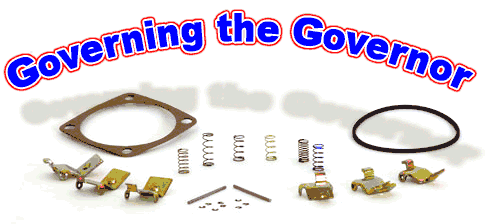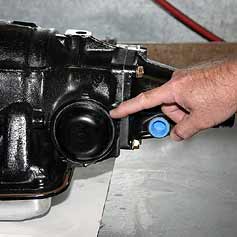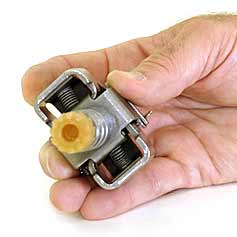| 
By Mike
Bumbeck
Photos courtesy B&M Racing & Performance
Products
9/9/04
 ine-tuning your engine-transmission and rear
gear combination for peak power delivery and
consistency can mean the difference between
going rounds, and rolling back on the trailer.
A few hundred extra or a couple hundred less
rpm on full throttle up shift can help keep
your power band in the sweet spot for maximum
horsepower and torque. ine-tuning your engine-transmission and rear
gear combination for peak power delivery and
consistency can mean the difference between
going rounds, and rolling back on the trailer.
A few hundred extra or a couple hundred less
rpm on full throttle up shift can help keep
your power band in the sweet spot for maximum
horsepower and torque.
In TH-350, TH-400, and 700-R4 automatic transmissions,
a governor controls part and full throttle
up-shifts. Think of the governor as a hydraulic
speedometer, which tells the transmission when
to shift up based on vehicle speed. The governor
turns in direct relation to the output shaft
rotation, and therefore vehicle speed. Inside
the governor is a valve that opens and closes
to "govern" the upshifts.
There are two sets of rotating weights in
the governor. The heavier, outer weights act
at low vehicle speed and the lighter inner
weights take over at higher speeds, especially
during full throttle conditions. Centrifugal
force acting upon the weights controls the
opening and closing of the governor valve itself.
The valve controls governor pressure delivery,
which in turn controls upshifts.
When there is enough centrifugal force upon
the weights to open the valve, line governor
pressure overrides the shift valve spring,
and the shift occurs. Changing the inner weights
on the governor allows you to adjust the rate
of this line pressure versus vehicle speed
balancing act, and optimize full throttle shift
points to your vehicles power to weight ratio,
rear end gear ratio, and so on.
Since the governor came set from the factory
for whichever vehicle the transmission originally
came in, you may or may not be getting the
most out of your setup. This is especially
true if you have changed rear end gear ratios.
The B&M Governor Recalibration Kit allows
for raising or lowering of transmission shift
points relative to vehicle speed. Keep in mind
that the governor has no effect on the crispness
or "hit" of the shifts. Modifications
to shift characteristics must be made by modifying
the valve body with a shift recalibration kit.
The first step in modifying your shift points
is to set a baseline. Record full throttle
shift point rpm and vehicle speed. Use this
first measurement for comparison to each change
made in the weights or springs of the governor.
In general, lighter weights bring later upshifts,
while heavier weights will bring them earlier.
Stiffer springs will produce stacked, closer
shifts where as weaker springs tend to space
shifts apart.
After each change record shift and speed information
again before making the next adjustment. It
is also possible to source a second governor
assembly from a salvage yard or trans shop.
In this way you can have a second unit ready
to swap in, or keep an extra for street use
and specific track conditions.
The first step in adjusting the governor is
to get the governor out of the transmission.
The governor can be removed with the transmission
in the car. In a TH-400 remove the four bolts
holding the cover assembly. Remove the cover
then governor itself by pulling out and turning
1/8 turn counter clockwise. In a TH-350, and
700-R4 first remove the cover clip, and the
governor itself.
 |
 |
| The location of the governor on a TH-350
is behind this cover. For TH-400 and 700R4
the location is the same, but the cover
is held in by four bolts. Allow time for
transmission to cool before starting work. |
The heavier outer weights will not be
replaced. Note the smaller inner weights
and springs. These are what can be recalibrated.
It is recommended that only ONE change
be made at a time. Replace either weights,
or springs, but not both. |

|